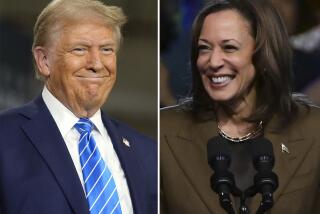Third-party candidates could shake up several races
- Share via
Reporting from Washington — Democrats faced with a resurgent Republican Party also find their chances in a handful of races potentially spoiled by strong third-party candidacies.
Florida’s Senate race, rocked in the closing days with the revelation Thursday that Kendrick Meek reportedly spoke with former President Clinton about potentially dropping out to endorse independent candidate Charlie Crist, is now the most prominent example.
But other races for Senate, governor and even congressional seats could see the outcome tipped by independents.
While Republican Marco Rubio is still seen as the likely winner in Florida’s three-way contest, the Alaska Senate race remains murky in the closing days. GOP nominee Joe Miller appears to be slipping in the polls, largely because of a surge of support for incumbent Lisa Murkowski, a Republican now waging a write-in candidacy after losing to Miller in the August primary.
If not for Murkowski, Democrat Scott McAdams might have capitalized on the unease with Miller among the state’s sizable percentage of independent voters. Instead, he appears to be battling for second place, though the uncertainty surrounding a write-in campaign makes the race a genuine toss-up.
Third-party candidates are more prevalent in gubernatorial races, including at least one in which an independent is the frontrunner. New England alone features three competitive three-person races. In Maine, three surveys this week show independent Eliot Cutler running even with or ahead of Democrat Libby Mitchell. But Republican Paul LePage leads the field, having consolidated the conservative vote.
Massachusetts Treasurer Tim Cahill, elected as a Democrat, is running now as an independent against incumbent Deval Patrick and Republican Charlie Baker. Cahill’s candidacy has been rocked in the past month by the departure of his top campaign advisers and even his running mate. Whether Patrick is re-elected may ultimately depend on just how many votes Cahill siphons away from Baker. A new internal poll from Baker’s campaign showed he and the governor tied at 40%, with Cahill earning 10% of the vote.
In Rhode Island, Democrats’ hopes of winning the governorship for the first time in 20 years are in jeopardy thanks to Lincoln Chafee, a former Republican U.S. Senator now waging an independent run. President Obama’s decision not to endorse Frank Caprio, in deference to his former Senate colleague, may prove to be the catalyst for Chafee’s late momentum.
Minnesota, which 12 years ago elected former wrestler Jesse Ventura as its independent governor, again has a viable third-party candidate: Tom Horner. But in this race Democrat Mark Dayton has had a small but consistent lead over Republican Tom Emmer.
A new study by the University of Minnesota’s Center for the Study of Politics and Governance identifies 443 independent candidates running for the House of Representatives this year, the most in a midterm election year since 1934.
But only a handful could prove to be impact-makers, according to Tim Sahd, editor of National Journal’s House Race Hotline.
In Florida’s 12th district, some Republicans fear a ‘tea party’ candidate could attract enough support to put a safe GOP seat in Democratic hands. In Michigan’s first district, businessman Glenn Wilson is running only in the single digits, but that could be enough to tip the balance in a closely watched race.
And in New York’s 23rd district, Conservative Party candidate Doug Hoffman is no longer running an active campaign, but remains on the ballot. A recent Siena poll still found him drawing double-digit support, enough perhaps to allow Democrat Bill Owens to win a full term.
Ironically, a similar scenario unfolded in a 2009 special election, which led to Owens being elected in the first place.
Twitter.com/mikememoli
More to Read
Get the L.A. Times Politics newsletter
Deeply reported insights into legislation, politics and policy from Sacramento, Washington and beyond. In your inbox twice per week.
You may occasionally receive promotional content from the Los Angeles Times.











